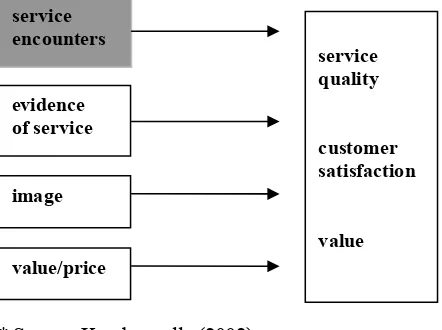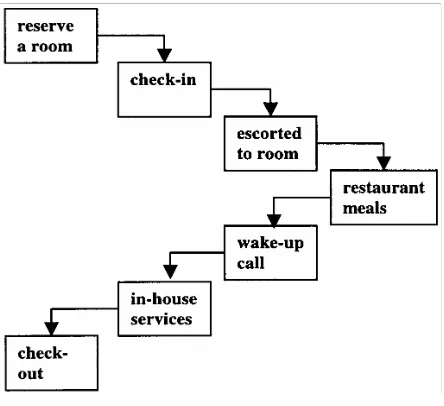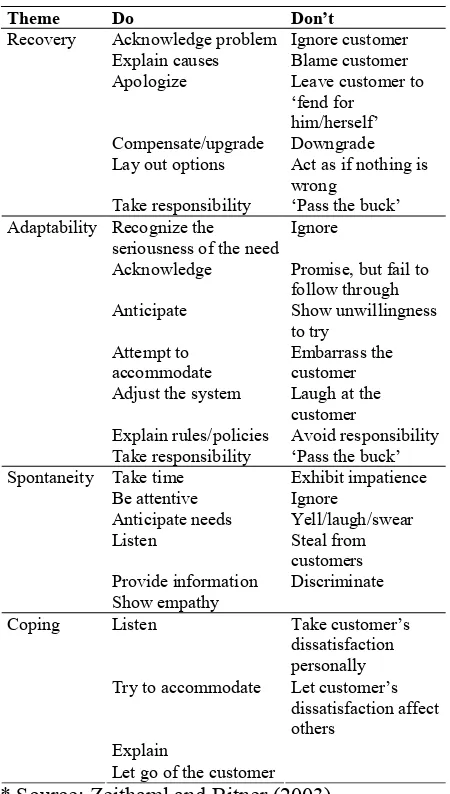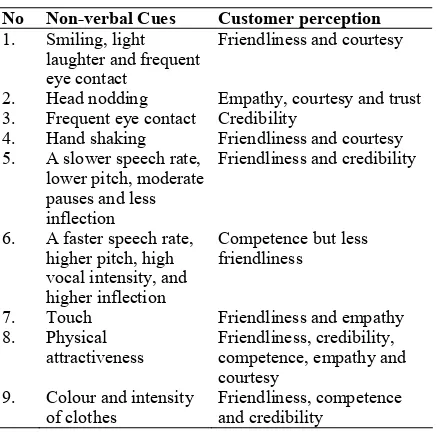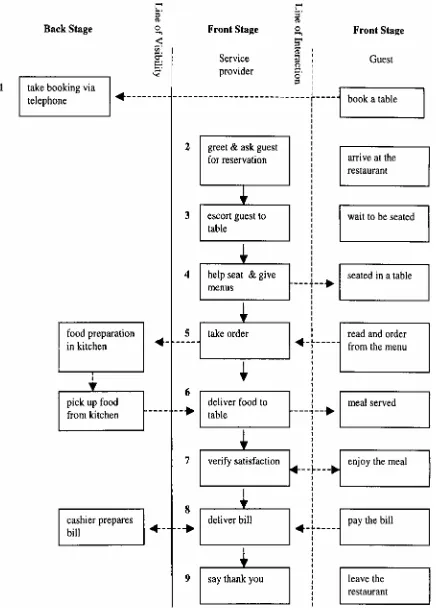Jurusan Manajemen Perhotelan, Fakultas Ekonomi – Universitas Kristen Petra http://puslit.petra.ac.id/journals/perhotelan/
THROUGH MANAGING THE ‘MOMENT OF TRUTH’:
A THEORETICAL APPROACH
Deborah Christine Widjaja
Lecturer, Hotel Management Program, Faculty of Economics, Petra Christian University Email: dwidjaja@peter.petra.ac.id
Abstract: Hospitality industry is one of the service businesses that pays so much attention to service quality as it is the main intangible product that it produces. This short article examines how to manage service quality in hospitality industry through managing the ‘moment of truth’ or service encounter. The analysis is done by referring to some problems and challenges in managing service encounters. The results of the analysis show some important points to consider when managing service encounters.
Keywords: Service quality, service encounter, moment of truth, non-verbal cues, service blueprint.
Delivering good service to customers is the main goal that every service business strives to accomplish from time to time. The ability for a service provider to deliver quality service is considered an essential strategy for success and survival in today’s competition. In this case, service encounter is a critical part of the service delivery process because it gives impact to customer’s evaluations of service consumption experiences (Zeithaml, Parasuraman, and Berry, 1990). Therefore, there have been several studies and researches focusing on service encounter as it is believed that there is a causal relationship between the customer perception of service quality and the service encounter. Service encounter is one of the factors influencing customer perceptions of service quality, satisfaction and value as shown in the figure 1.
* Source: Kandampully (2002)
Figure 1. Factors Influencing Customer Percep-tions of Service
Hospitality industry is one of the service sector, with relatively high level of customer contact. The higher the level of customer contact the more numerous and longer service encounters between customers and service employees. It implies that more attention must be focused on how to manage all the possible service encounters which will much influence the service quality of the hospitality organization and in the end the profit (Zeithaml, Valarie, Berry and Parasuraman, 1996). Many hospitality organizations have invested considerably to develop service-delivery system which will ensure that customers will receive consistently high-quality service in every service encounter (Kotler, Bowen and Makens, 2003, p. 49) This makes service encounter or ‘moment of truth’ in hospitality industry become much more important to be taken care of in the future.
While considerable research has been conducted in the service sector in general focusing on service encounters (Lemmink and Mattsson, 2002; Price, Arnould and Deibler, 1994; Mattila, 1999; Bebko, 2001; Sundaram and Webster, 2000), specific concern in managing service encounters in hospitality industry has received very little attention. The objectives of this article are to explore from a theoretical perspective how to manage service quality through managing the service encounters that takes place in hospitality industry. It also aims to set a framework of investigation for future empirical research.
SERVICE QUALITY
Service quality is determined by what customers perceive. It means that customers play an important
service encounters
evidence of service
image
value/price
service quality
customer satisfaction
part in judging service quality. Very often companies define service quality apart from what the customers perceive of the quality so that time and money are poorly invested to poor quality programs. Grönroos (2000) identified two dimensions in service quality as it is perceived by customers; they are technical quality and functional quality (see figure 2). The technical quality is the outcome or the end result of a service production process. The functional quality is how a customer receives the service and how he experiences the simultaneous production and consumption process. All the tangibles will create the technical quality but the intangibles will generate the functional quality. For example in a restaurant setting, the delicious food served to the guest is the technical quality of a service; while how the guest is treated and served by the waiter is the functional quality. Both of them give influence to the customer in perceiving the service quality. Very often the service provider who performs better in functional quality will gain competitive advantage when most of service providers provide relatively the same technical quality.
* Adapted from: Kandampully (2002)
Figure 2. Technical Quality and Functional Quality Service Quality Dimensions
In evaluating service quality, consumers consider five dimensions (Zeithaml and Bitner, 2000, p. 82): 1. Reliability: ability to perform the promised service
dependably and accurately
2. Responsiveness: willingness to help customers and provide prompt service
3. Assurance: employee’s knowledge and courtesy and their ability to inspire trust and confidence 4. Empathy: caring, individualized attention given to
customers
5. Tangibles: appearance of physical facilities, equipment, personnel, and written materials
These dimensions are generally considered by consumers when they want to procure a service or when they want to estimate service quality. In the same way, these dimensions are very much contemplated when consumers experience the ‘moment of truth’.
SERVICE ENCOUNTER OR “MOMENT OF TRUTH”
The term service encounter and ‘moment of truth’ are used interchangeably when discussing the period of time where customers interact directly with a service. As it is stated by Lovelock (2002) that ‘moment of truth’ is “a point in service delivery where customers interact with service employees or self-service equipment and the outcome may affect perceptions of service quality” (p. 55). In the ‘moment of truth’, a careless mistake by an employee, a rude behavior or an unanticipated request by a guest can result in a dissatisfied guest (Kotler, 2003, p. 353). It is the crucial moment for service provider to influence customer perception of service quality. For example, a hotel guest may experience several service encounters when booking a room, checking into the hotel, being escorted to a room by a bellman, having meals in the hotel restaurant, requesting a wake-up call, using in-house services, and checking out (see figure 3). In these encounters hotel guests receive a picture of the hotel’s service quality and each encounter contributes to the hotel guest’s overall satisfaction and willingness to do business with the hotel organization again. As for the hotel, each encounter is an opportunity to deliver quality service to guests.
* Adapted from: Kandampully (2002)
Figure 3. ‘Cascade’ in ‘moments of truth’ For a Hotel Visit
service quality, doubtful of its consistency in service delivery, and vulnerable to the appeals of compe-titors” (Zeithaml and Bitner, 2003, p. 101). Besides, each encounter with different people and departments in an organization will also add to or detract from the potential for a continuing relationship.
Types of Service Encounters
There are three general types of service encoun-ters in the hospitality industry: remote encounters, phone encounters, and face-to-face encounters (Zeithaml and Bitner, 2003, pp. 102-104). Remote encounters can occur without any direct human contact, such as: booking a room via the Internet. In this case the technical quality is the only point to control as there is no direct interaction with the service provider. While the phone encounter is the type of encounter between an end customer and the organization which occurs over the telephone, such as: booking a room or a table via telephone. In this case, tone of voice, employee knowledge, and effectiveness/efficiency in handling customer issues become important criteria for judging service quality. As for face-to-face encounters, there is a direct contact between an employee and a customer. Both verbal and nonverbal behaviors are important determinants of service quality as well as the tangible cues such as employee attire, equipment, physical setting and other tangible symbols.
Analysis of Problems and Challenges in Managing Service Encounters
In order to avoid negative service encounters but ensure positive service encounters are in place, it is necessary to find out what sort of things may bring customer satisfaction and what other sort of things may cause customer dissatisfaction in a service encounter.
First of all, there are four common themes identified as the sources of customer satisfaction/ dissatisfaction in memorable service encounters (Zeithaml and Bitner, 2003, pp. 104-107):
1. Recovery: employee response to service delivery system failures
2. Adaptability: employee response to customer needs and requests
3. Spontaneity: unprompted and unsolicited em-ployee action
4. Coping: employee response to problem customers
Failure to respond to the four themes accordingly will result in customer dissatisfaction. Therefore, under-standing general service behavior is important to anticipate as much as possible the positive service encounters instead of the negative ones (see table 1).
Table 1. General Service Behaviors – Do’s and Don’ts
Theme Do Don’t
Acknowledge problem Ignore customer Explain causes Blame customer Apologize Leave customer to
‘fend for
Take responsibility ‘Pass the buck’ Recognize the
seriousness of the need Ignore
Acknowledge Promise, but fail to follow through
Anticipate Show unwillingness
to try Attempt to
accommodate
Embarrass the customer Adjust the system Laugh at the
customer
Explain rules/policies Avoid responsibility Adaptability
Take responsibility ‘Pass the buck’ Take time Exhibit impatience Be attentive Ignore
Anticipate needs Yell/laugh/swear
Listen Steal from
customers Provide information Discriminate Spontaneity
Show empathy
Listen Take customer’s
dissatisfaction personally Try to accommodate Let customer’s
dissatisfaction affect others
Explain Coping
Let go of the customer * Source: Zeithaml and Bitner (2003)
that so much deviates from the expected service quality. As a result, the service provider will be able to prevent customer dissatisfaction from occurring or at least minimize it so that service quality will be better accomplished.
Thirdly, another point of consideration should also be given to non-verbal communication when managing service encounters. It is commonly known that employee’s display of affective characteristics such as “friendliness, responsiveness, and enthusiasm positively influences customer’s overall evaluation of service encounter and perceptions of service quality” (Sundaram and Webster, 2000, p. 378). Moreover, Sundaram and Webster (2000) add that both “verbal and non-verbal elements of communication between the service provider and the customer influence customer’s affect or subjective feelings, which in turn influence their evaluation of the service encounter”. There are several non-verbal cues influencing service encounters, they are (Sundaram and Webster, 2000, p. 390):
1. Kinesics – body movements such as eye contact, nodding, hand shaking, smiling and adopting a relaxed and open posture;
2. Paralanguage – vocal pitch, vocal loudness or amplitude, pitch variation, pauses and fluency; 3. Proxemics – the distance and relative postures of
the service provider and customer, and particularly the use of touch; and
4. Physical appearance.
Sundaram and Webster suggest that those non-verbal cues affect the customer perception in a certain tendentious way as seen in the table 2 below:
Table 2. Customer Perception of Service Provider Non-verbal Cues
No Non-verbal Cues Customer perception 1. Smiling, light
laughter and frequent eye contact
Friendliness and courtesy
2. Head nodding Empathy, courtesy and trust 3. Frequent eye contact Credibility
4. Hand shaking Friendliness and courtesy 5. A slower speech rate,
lower pitch, moderate pauses and less inflection
Friendliness and credibility
6. A faster speech rate, higher pitch, high vocal intensity, and higher inflection
Competence but less friendliness
7. Touch Friendliness and empathy 8. Physical
attractiveness
Friendliness, credibility, competence, empathy and courtesy
9. Colour and intensity of clothes
Friendliness, competence and credibility
* Adapted from Sundaram and Webster (2000)
When service employees know exactly what are expected from them in terms of non-verbal behavior besides the verbal communication, they will be able to enhance their effective communication skill verbally and non-verbally. As the effective communi-cation skill increases, the service encounter or ‘moment of truth’ will more positive and the perceived service quality will be enhanced as the five dimensions of service quality are met accordingly.
Nevertheless, it needs some endeavor from the hospitality managers to build the service employee awareness of the importance of non-verbal behavior besides verbal communication in attaining effective communication skill that will enhance service quality. Sundaram and Webster (2000) suggest that in order to make service employee more sensitive to non-verbal cues, the managers can utilize role-playing and show videotapes of actual service delivery which demonstrate both the positive and negative non-verbal cues. Continuous feedback will also be useful to remind service employees of the importance of non-verbal communication. Periodic surveys, in addition, are important to assess customers’ percep-tions of service employees’ non-verbal behavior. Providing incentives can be desirable to encourage service employees to implement the recommended changes in non-verbal behavior (p. 391).
Thirdly, culture and purchase motivation become two other points to consider when attempting to manage service encounters. The involvement of people in service delivery implies that cultural diversities and norms quickly come into play when customers evaluate service encounters. This is obviously relevant especially in the hospitality industry where there is so much cultural exposure either with the international guests or among the service employees themselves.
service as their culture less accepts of status differences.
Nevertheless, when these two different groups of culture are opposed to purchase motivation, the expectation will be different. For business customers regardless of cultural background, they tend to focus on the output not the style of the service delivery. They are more interested in efficiency (including the speed of service) than in the functional quality of the interaction. Business customers driven by the need for efficiency might focus on the “service outcome” rather than on the “feelings” generated by the service encounter. Leisure customers, in contrast, tend to be more heterogeneous in their expectations according to their cultural background. Asian leisure customers tend to prefer “high-context communication” in which non-verbal cues are more important than explicit expressions. Asian leisure customers expect to be treated as “deserving of high-quality service” (Mattila, 1999). Likewise, some non-verbal cues may vary from culture to culture. Eye contact, for example, is very much expected by the Americans whereas in many Oriental cultures it is not proper to look in the eye too often someone who is superior. In fact, a bowed head represents a signal of respect to an authority figure (Barnum and Wolniansky, 1989).
Consequently, it is essential for hospitality organizations to develop employee training programs for guest-contact employees, such as: the Front desk employees in the hotel industry, to ensure that they are able to deliver the service the ‘right’ way. As for the organizations that expect to cater International guests, they need to give the employees a multi-cultural training program which includes a language training program and cross-cultural understanding to meet the possible cultural expectations of their foreign guests (Jafari and Way, 1994). This idea is in line with a research finding signifying that Front desk employees’ performance is critical to guests’ baseline evaluation of a hotel’s service quality (Michael, Wooldridge and Jones, 2003). As for the restaurant, the waiters or waitresses should be trained well so that they will be more aware of how to be able to serve better according to what is expected by the guests and to have more control over the ‘moment of truth’.
SERVICE BLUEPRINT
Service blueprints are pictures or maps of service processes that permit the people involved in designing, providing, managing, and using the service to better understand them and deal with them objectively. A service blueprint simultaneously
depicts the service process and the roles of consumers, service providers, and supporting services.
Blueprints are designed by identifying and mapping a process from the consumer’s point of view, mapping employee actions and support activities, and adding visible evidence of service at each consumer action step. Key components of service blueprints are consumer actions, “onstage” and “backstage” employee actions, and support processes. Service blueprint accentuates the customer interactions in the service operations processes and, that the line of visibility separated activities of the front stage, where customers obtained tangible evidence of the service, from the back office pro-cessing, which was out of customer view (Tseng et al., 1999). Hence, the service blueprint can facilitate problem solving and create thinking by identifying potential points of failure and highlighting oppor-tunities to enhance customers’ perceptions of the service. Figure 4 is presented to serve as an example of a service blueprint of restaurant standard service which clearly defines the front stage and the back stage performance that will influence service encounter experienced by the guests.
*Writer’s presentation
ANALYSIS OF THE SERVICE ENCOUNTERS There are basically nine kinds of service encounters that happen in the service blueprint above as there are interactions between the service employee and the guest. First of all, when the guest calls the restaurant and books a table, there is a telephone interaction between the guest and the service employee who picks up the telephone. This is the first encounter or ‘moment of truth’ in which the guest will judge the service quality by evaluating the words spoken by the restaurant employee as well as the tone of voice or the non-verbal cues, in this case, the “paralanguage”. In this ‘moment of truth’, it is very important that the service employee speaks the ‘right’ words in the ‘right’ way so that the guest will a first good impression about the service quality of the restaurant in his mind and he would want to go on to the next service encounter.
In this encounter, the guest will judge the service quality whether it is courteous, friendly, credible, competent and empathetic or not at all. Very often restaurants fail to attend to this very first encounter in the ‘right’ way. They fail to instill a good impression or even an excellent one about the service quality in the first place. This can happen since there is a different perception between the guest and the restaurant employee as the service provider on the “point of activation” when the first action in the service encounter begins (Hubbert et al., 1995). It often happens that the service provider perceives that the first action in the service encounter starts when the guest actually arrives and enters the restaurant whereas the guest evaluates the first service encounter at the very first moment he or she contacts the restaurant and has the conversation with a restaurant employee. This can be a critical point in the ‘moment of truth’ in which the service provider needs to take care.
Secondly, when the guest arrives at the restaurant and he is greeted by a greeter who then asks for the reservation. This leads to the second interaction between the guest and the service employee but this time, it is more than just verbal communication but also non-verbal communication as there is direct contact between the two. When greeting the guest, it is important for the service employee to also demonstrate the ‘right’ non-verbal cues besides the verbal and tangible cues since all those cues will compose the overall notion of the service quality. In this stage, the service encounter will confirm the previous telephone encounter when the guest evaluates the service quality. In this case the critical point will be the credibility and friendliness of the service employees in welcoming the guests.
Then for the next service encounters (number 3-5), the guest will experience the next interaction with the service employee when he or she is being escorted to the table and seated. In this case the body language matters most as there will be less verbal communication but more non-verbal communication. Brenner (1998) noted on the powerful influence of body language on giving impact on others. The impact someone makes on others depends on what he or she actually says (7%), how he or she says it (38%), and by his or her body language (55%). Besides, 93% of someone’s emotion is communi-cated non-verbally without actual words. That is why it is of vital importance to pay attention to the body language and to make sure that the ‘right’ body language is shown during the service delivery. The body language can demonstrate whether the service employee is friendly, courteous and credible. As mentioned in the previous part it appears that some non-verbal cues are different from culture to culture. That is why it is imperative that the service employee is aware of multicultural cues and able to perform eventually the ‘multicultural’ body language depen-ding on the situation. The ‘right’ body language will generate good service encounters. In the end, good service encounters accumulated over time maintain a long-term exchange relationship between customers and organization.
In the next service encounters (number 6-7), when the guest enjoys the meal, besides the tangible things like the meals served, decoration and atmosphere of the restaurant, the attentiveness and responsiveness of the service employees will be the important points the guest evaluates in judging the service encounter. The judgment of the service encounter will be positive when the guest’s expectation is met or even exceeded.
In the last service encounters (number 8-9), even though it is the last ‘moment of truth’ but it is also a crucial moment to take care it will leave a ‘good’ or ‘terrible’ last impression about the overall restaurant service. When the service provider neglects this last crucial moment, it may happen that the last ‘terrible’ moment will distort the whole first ‘good’ impression.
CONCLUSION
Service encounter or the ‘moment of truth’ is one of the predictors of service quality. It is a point in service delivery where there is an interaction between the service employee and the customer. Therefore, accomplishing a positive service encounter is very important. When the service provider is able to understand and meet customer’s expectation, positive service encounter will be attained. After analyzing the problems and challenges in managing service encounters, several points can be drawn in attaining positive service encounters:
1. Customers generally consider the way how the service employee or service provider performs recovery efforts, how adaptable the service employee or service provider is, how good is the spontaneity and how good the service employee or service provider is in coping customer’s problems;
2. Adding more tangibility in the service encounter will minimize the risk of having a big gap between customer expectation and perception; 3. Non-verbal communication should be considered
as 93% of the impression formed in the customer’s mind is determined by non-verbal cues;
4. Cultural aspect is another point that will influence the service encounter. The ability for a service provider to respond culturally up to standard will be a strong point to develop a positive service encounter;
5. Purchase motivation is also another point to consider when attempting to manage service encounter as it contends with customer’s expec-tation;
6. Last but not least, the effective use of service blueprint in managing the ‘moment of truth’ will help service provider trace some critical points in the ‘moment of truth’ when special attention is necessary so that the service provider will have more control over the service encounters. Even for more complicated hospitality organizations like hotels, for example, having detailed service blueprint for every service operation will help them have more control over service encounters and ensure service excellence.
RECOMMENDATIONS
There are several recommendations to propose: 1. It is essentially important for the hospitality
organizations to equip the service employees with the skill to manage service encounters, such as: a. Help them be familiar with the general service
behaviors, the do’s and the don’ts
b. Help them be able to produce the ‘right’ non-verbal cues
c. Help them realize the cultural aspects
influencing service encounters
2. Several kinds of trainings are necessary such as: multicultural training programs, language training programs and so on.
3. Developing the service blueprint is useful in anticipating the potential points of service failures and emphasizing on opportunities to enhance customers’ perceptions of the service and create a more positive service encounter.
4. Further empirical research should be done on the multicultural service behaviors and its effects on service encounters.
REFERENCES
Barnum, C and Wolniansky, N. (June, 1989), “Taking cues from body language”, Mana-gement Review, 59-60.
Bebko, C. (2001), “Service encounter problems: Which service providers are more likely to be blamed?”, Journal of Services Marketing, (15), 6, 480-495.
Brenner, R.C. (2001), “Body language in Business: How to sell using your body”,
www.brenner-books.com, Brenner Information Group, July
10, 2001
Grönroos, C. (2000), Service management and mar-keting: A customer relationship management approach, (2nd ed), Wiley, Chichester.
Hartline, M., Wooldridge, B. and Jones, K. (Febru-ary, 2003), “Guest perceptions of hotel quality: determining which employee groups count most”, Cornell Hotel and Restaurant Adminis-tration Quarterly, 43-52.
Hubbert, A. R., Sehorn, A. G. and Brown, S.W. (1995), “Service expectations: The consumer versus the provider”, International Journal of Service Industry Management, (6), 1, 6-21.
Jafari, J. and Way, W. (December, 1994), “Multicul-tural strategies in tourism”, Cornell Hotel and Restaurant Administration Quarterly, 72-79.
Kandampully, J. (2002), Services management: The new paradigm in hospitality, Hospitality Press, Pearson Education Australia.
Lemmink, J. and Mattsson, J. (2002), “Employee behavior, feelings or warmth and customer perception in service encounters”, Internatio-nal JourInternatio-nal of Retail & Distribution Mana-gement, (30), 1, 18-33.
Lovelock, C. and Wright, L. (2002), Principles of service marketing and management, (2nd ed), Prentice-Hall, Upper Saddle River, NJ.
Mattila, A.S. (1999), “The role of culture and pur-chase motivation in service encounter
evaluations”, Journal of Services Marketing, (13), 4/5, 376-389.
Price, L., Arnould, E. and Deibler, S. (1994), “Consumers’ emotional responses to service encounters: the influence of the service provi-der”, International Journal of ServiceIndustry Management, (6), 3, 34-63.
Sundaram, D. and Webster, C. (2000), “The role of nonverbal communication in service encoun-ters”, Journal of Services Marketing, (14), 5, 378-391.
Tseng, M. M., Qinhai, M and Chuan-Jun S. (1999), “Mapping customers' service experience for operations improvement”, Business Process Management Journal, (5), 1, 50-64.
Zeithaml, V. and Bitner, J. (2000), Services market-ing: Integrating customer focus across the firm, (2nd ed), McGraw-Hill, Boston.
Zeithaml, V. and Bitner, J. (2003), Services market-ing: Integrating customer focus across the firm, (3nd ed), McGraw-Hill, Boston.
